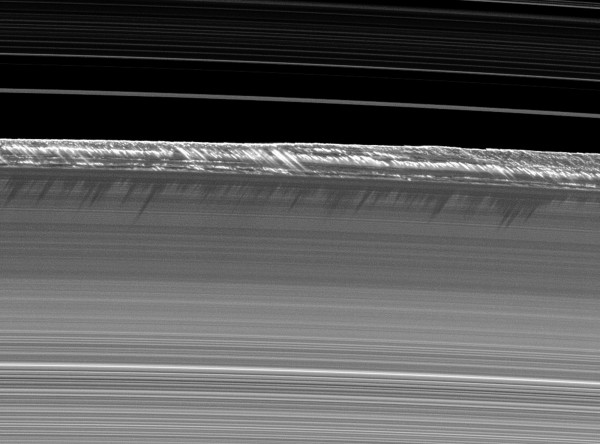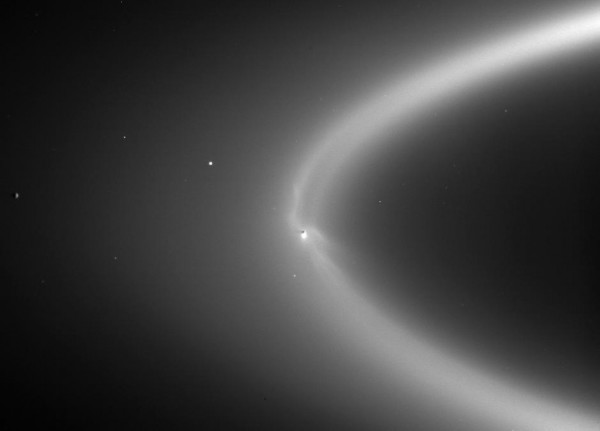“This then, I thought, as I looked round about me, is the representation of history. It requires a falsification of perspective. We, the survivors, see everything from above, see everything at once, and still we do not know how it was.” -W.G. Sebald
In the 1600s, the earliest telescopes saw that Saturn had "ears," while later observers all the way back then finally saw their true nature: a ringed system with complex gaps, bands and colorations throughout. Since then, Saturn’s rings have been a source of wonder and puzzlement to skywatchers everywhere. The only ring system visible through most telescopes from Earth, Saturn’s main rings measure more than 70,000 km long, yet are no more than 1 km in thickness.
Once thought to have only two gaps in them, the Cassini spacecraft has revealed over a thousand, teaching us that Saturn’s rings are ancient -- likely as old as the planet itself -- and will likely continue to exist for as long as our Sun shines.



I wonder how *old* Saturn’s rings are.
And if scientists think they know, I wonder why they do.
“Research on the mass of Saturn's rings has important implications for their age. A less massive ring would evolve faster than a ring containing more material, becoming darkened by dust from meteorites and other cosmic sources more quickly. Thus, the less massive the B ring is, the younger it might be -- perhaps a few hundred million years instead of a few billion.”
http://saturn.jpl.nasa.gov/news/cassinifeatures/feature20160202/
@See Noevo #1
The latest research has them at 100 million years old. There is an article here with explanations and links to the published work:
http://www.seti.org/seti-institute/press-release/moons-saturn-may-be-yo…
To Denier #2:
Isn’t Saturn considered to be 4.6 billion years old, like our solar system?
If so, I wonder what was going on for the first 4.5 billion years before that ring appeared. And why it appeared then.
@See Noknowledge #3: Still can't read with comprehension, eh?
Ethan, a good future topic might be the evidence for against ancient or not so ancient age for the ring system. Since it had been the conventional wisdom that they were ancient, but we now have a study which claims they must be young. Give us your opinion on the relative credibility of the different arguments please.
@See Noevo #3
In order for multiple moons to orbit a single planet for a long period, all of the orbits must be resonant. If all orbits are not resonant then they are unstable. Moons can move inward. Moon can plunge into the planet. Moons can move outward or be ejected entirely. Moons can collide. That is what we have with Saturn.
As its satellites have moved around in their orbits, Saturn may have developed and cleared its rings many times. It will continue to be a chaotic mess until the moons finally find a resonance. The work linked above suggests the latest incarnation of Saturn's rings are ~100 million years old.
To Denier #6:
Yikes!
We should than our lucky stars.
We were fortunate with our moon.
For those of you in the northern hemisphere, tonight's sky is quite a great sight and wonderfull alignment. Sirius, Procyon, Capella and Aldebran make a great square around Orion, and just atop Betelgeusse, there's a cresent Moon. Just awesome sight!
Translation: It sucks to be you PJ. I'm sure you'll have a good view of kangaroos or something.
It works both ways; there are sights we get to see that northerners don't. Some of us have learned to take the good with the bad. If it were not raining, I would have been able to see most of the apparition; Perth is only 30 odd degrees south, not the south pole. :)
"And if scientists think they know, I wonder why they do."
Because they think they have evidence.
Dumbass.
"Translation: It sucks to be you PJ. "
Translation: Denier doesn't know that Orion is very visible from the Southern Hemisphere.
"If so, I wonder what was going on for the first 4.5 billion years before that ring appeared. "
It didn't have a ring.
Dumbass.
Valuable article ! I Appreciate the information - Does anyone know if I can obtain a blank MO DWC WC-G-11 copy to type on ?
The comment by "Leta" was a failed attempt to spam for altomerge-dot-com, BTW.